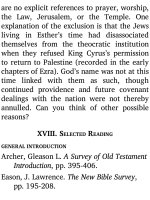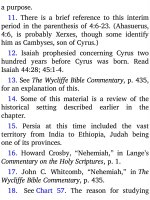Jensens survey of the old testament adam 460
Bạn đang xem bản rút gọn của tài liệu. Xem và tải ngay bản đầy đủ của tài liệu tại đây (158.11 KB, 4 trang )
When Paul visited Corinth for the rst
time in A.D. 50 on his second missionary
journey, he must have been impressed by its
stately buildings and bustling commerce.
This Greek city was widely acclaimed as the
hub of the Roman Empire’s commerce, a
strategic position that Paul no doubt coveted
for the advantage of propagating the gospel
of Jesus Christ.
The following descriptions will help you
appreciate what Paul saw, learned, and
experienced concerning the city and its
people.
1. Name. The Greek name Korinthos means
“ornament.”
2 . Geography. Observe on Map R the
strategic location of Corinth on the fourmile-wide isthmus between the Ionian and
Aegean seas.4 Shippers moving cargo
between Italy and Asia Minor via Corinth
avoided the dangerous voyage around the
southern tip of Greece. Small ships were
moved across the isthmus by tramway, or
cargo of the larger ships was transferred to
transports waiting at the eastern port.5
3 . History. Corinth’s ancient history
revolves around two events: (1) the
destruction of the old city by the Roman
general Mummius, 146 B.C.; and (2) the
rebuilding of the city by Julius Caesar, with
its gaining of status as a Roman colony, 46
B.C. How old, then, was the new city when
Paul first visited it?
4 . Population. Estimates of size in Paul’s
day vary from 100,000 to 700,000. There
was a mixture of races (Roman, Greek,
Oriental) and a large distribution of mobile
occupations (e.g., sailors and businessmen).
A very large proportion of its population
was composed of slaves.
MAP R: GEOGRAPHY OF CORINTH, SHOWING
CORINTHIAN GULF AND CANAL
5 . Political status. Corinth was a Roman
colony, the capital of the province of Achaia.
Gallio was proconsul of the province during
Paul’s visit (Acts 18:12).
6. Moral condition. The depraved character
of the old city of Corinth, exempli ed by
prostitute priestesses serving in the temple
of Aphrodite,6 goddess of beauty and love,
was carried over into the new city of New
Testament times. The very Greek word
korinthiazomai (“to act the Corinthian”)
came to mean “to commit fornication.” One
writer has described Corinth as “a seaman’s
paradise, a drunkard’s heaven, and a
virtuous woman’s hell.”7
7. Activities.
a. Commerce. Movement of shipping
across the isthmus was Corinth’s number
one business. Some of its own manufactured
products included items of pottery and
brass.
b. Education. Study of the arts and
sciences ourished. There were studios of
language and schools of philosophy. Yet
Paul, raised in the environment of the
university at Tarsus, and trained under the
great teacher Gamaliel, was keen to detect
an intellectualism that was both smug and
super cial. (Read some of Paul’s references
to knowledge and wisdom in such passages









